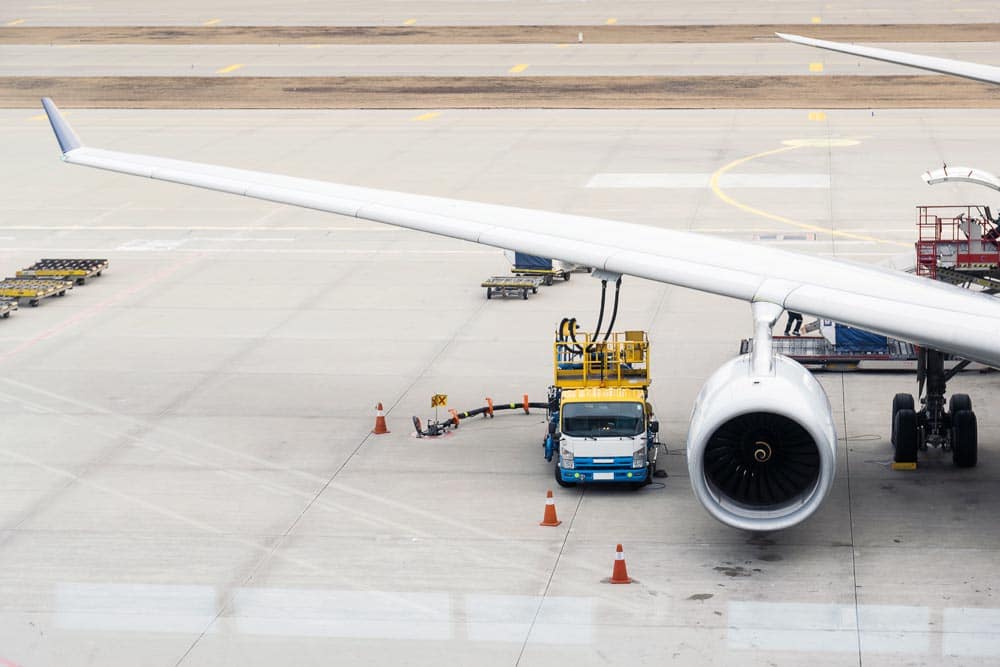The fuel utilized by commercial aircraft is surprisingly alike to the one used in cars!
Fuel is an important point of conversation in the aviation industry, with its varying cost impacting airline prices and profits every quarter. But what exactly is this fuel made out of? What are there different types of aviation fuel? Here’s a quick guide.
Aircraft use jet fuel or Aviation Turbine Fuel

Today, commercial aircraft use jet fuel or Aviation Turbine Fuel (ATF), a specific power source. The two most common fuels are Jet A and Jet A-1. While the former is used nearly exclusively in the US, the latter is operated globally. Both are made up of kerosene, a product of extremely refined oil. What differentiates jet fuel is the presence of several additives to ensure the fuel can be used safely without crystallization or ignition.
The difference between Jet A and A-1 is minimal, with the former having a more elevated freezing point (-40 C v -47 C) and the latter having an additional anti-static additive to the fuel. Their flash point and energy density are nearly identical, so both can be utilized interchangeably on a commercial jet plane.
The last type of jet fuel is Jet B, which is mostly used in extremely cold environments. Jet B is made up of 30% kerosene and 70% gasoline, giving it a freezing point of -60 C. However, this type of fuel is extremely flammable and challenging to manage, with most operators eschewing its use but for the military or for specific commercial missions.
Also, read
- Gold biscuits Rs 1.37 crore found hidden under passenger seat on Indigo flight from Dubai
- Alliance Air’s Bhuj-bound aircraft takes off from Mumbai Airport without an engine cover
- New rules- ‘One Hand Bag’ allowed with single check-in baggage in domestic Flights
Jet A or Jet A-1 fuel in your diesel vehicle
While jet fuel may seem like it is far released from your average gas pump fuel, they are extremely alike. Indeed, you could Jet A or Jet A-1 fuel in your diesel vehicle with little noticeable issues. While over time there will be degradation of key parts, if you ever discover yourself in the bizarre situation of having access to jet fuel and not normal diesel, it’s not the end of the world.
However, don’t try this on your petrol or gas car, since the effect would be exact as filling it up with diesel. All three are derivatives of crude oil, simply refined to different standards for their usage.

However, attempting to operate anything but jet fuel in a plane can be difficult. Indeed, ATF is regulated globally to confirm that it has the correct additives and is delivered in the safest possible way before leaving.
While jet fuel may be alike to normal fuel for numerous people, it’s the amount demanded that prices airlines millions every month. An Airbus A321neo can burn almost 42 liters of fuel every minute, suggesting that a two-hour domestic hop needs over 5,000 liters of jet fuel.
Sustainable Aviation Fuel (SAF)
In current years, the aviation industry has been focusing on moving away from purely crude oil-based fuel to Sustainable Aviation Fuel (SAF).

The most promising advancement has been biofuel, which is made from vegetable oils, plant materials, and more. Today, biofuels are only being used in conjunction with ATF and it will be a few more years before biofuels become the majority source for flight. However, the trend towards SAF has already started and the fuel we use is set to change for interest in the next decades.
Thank you
Stay updated with Aviationa2z.com
